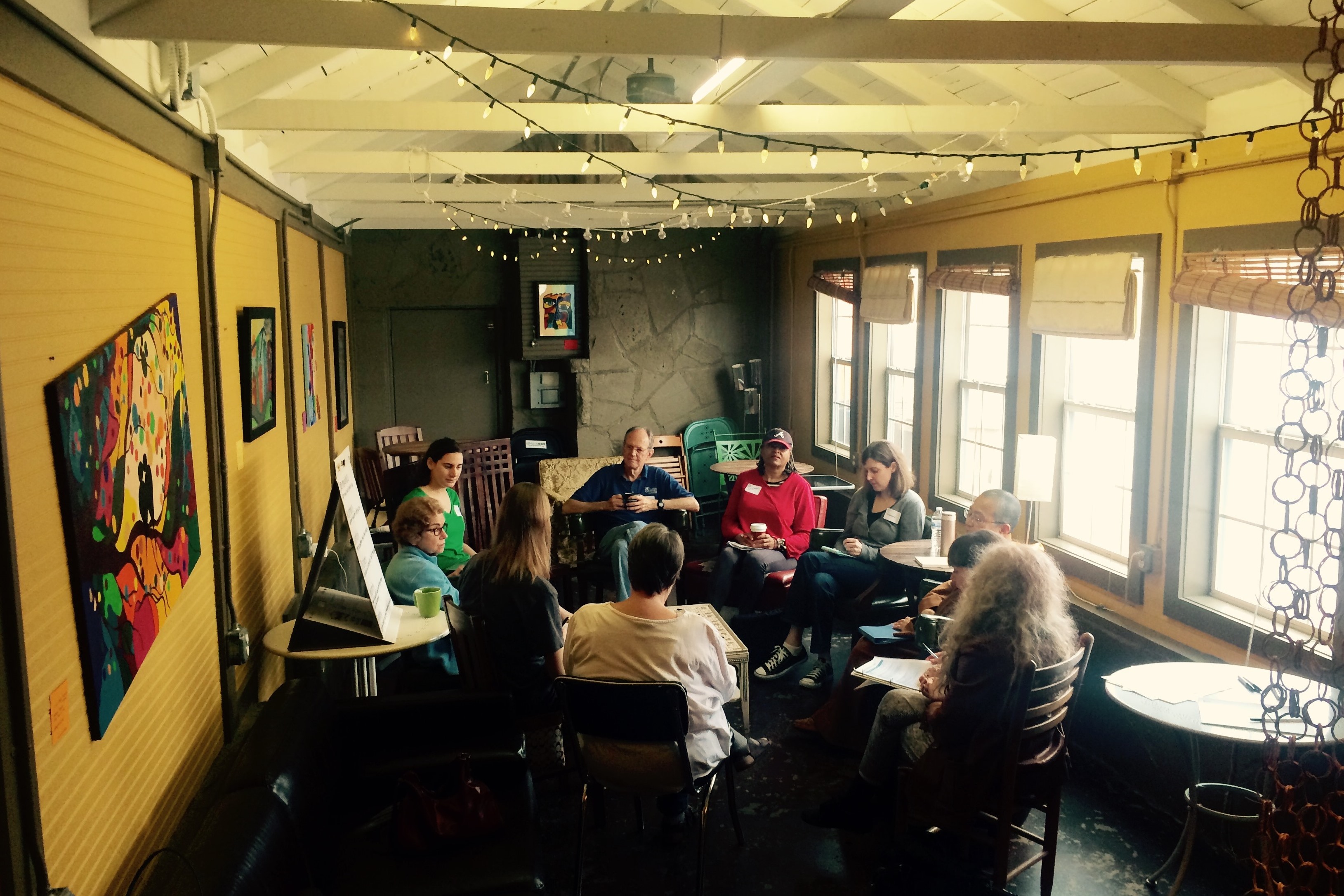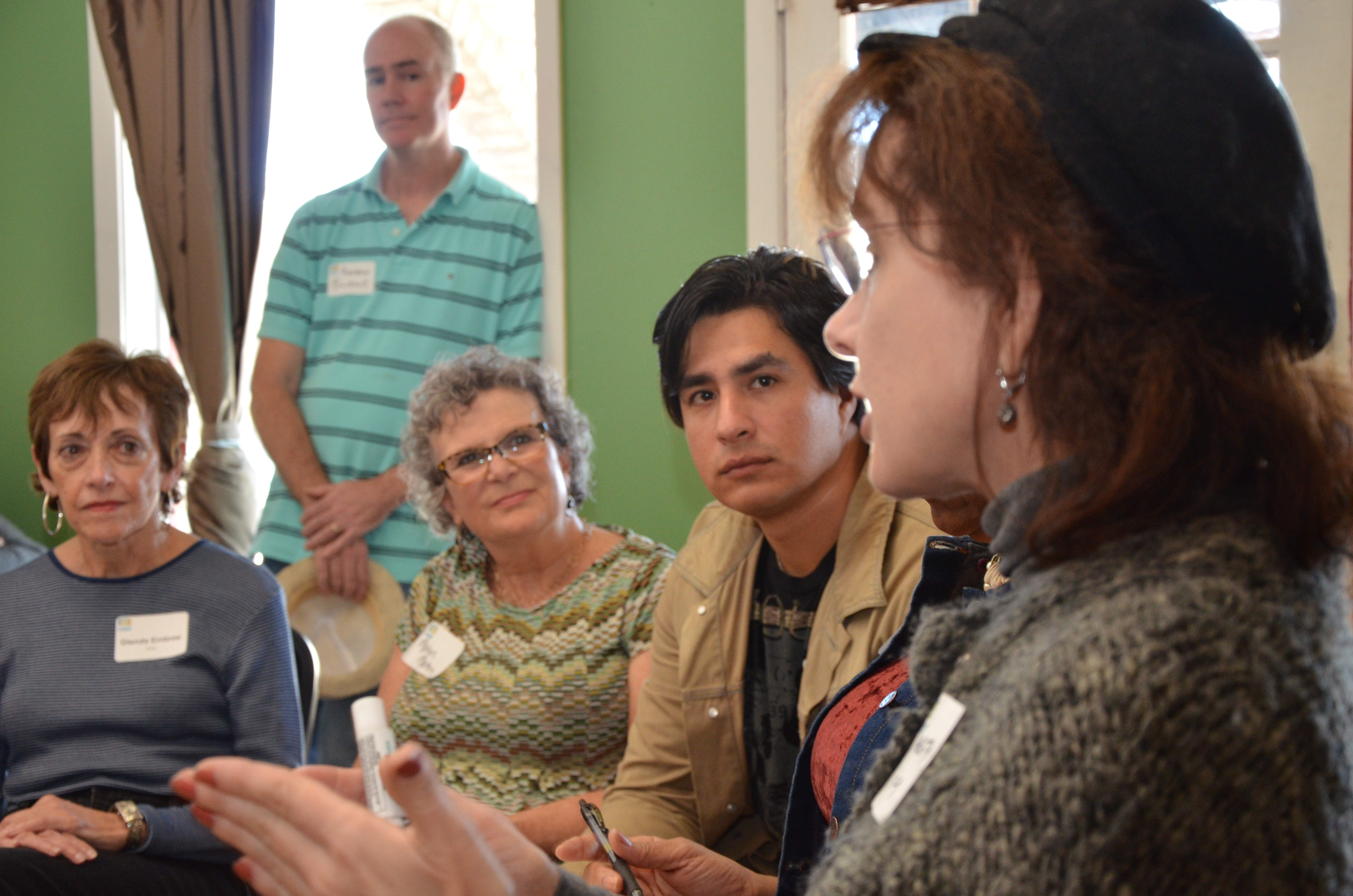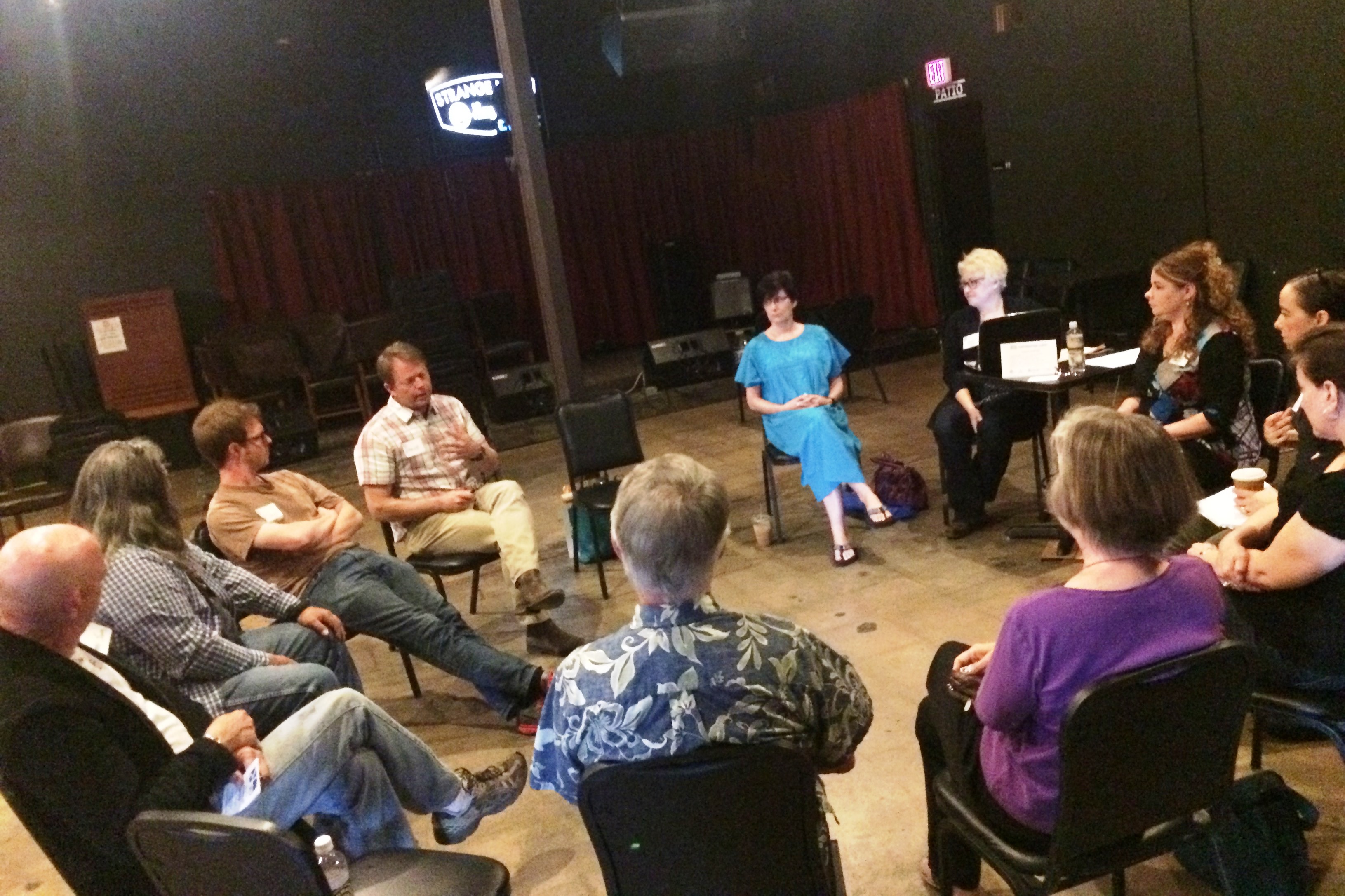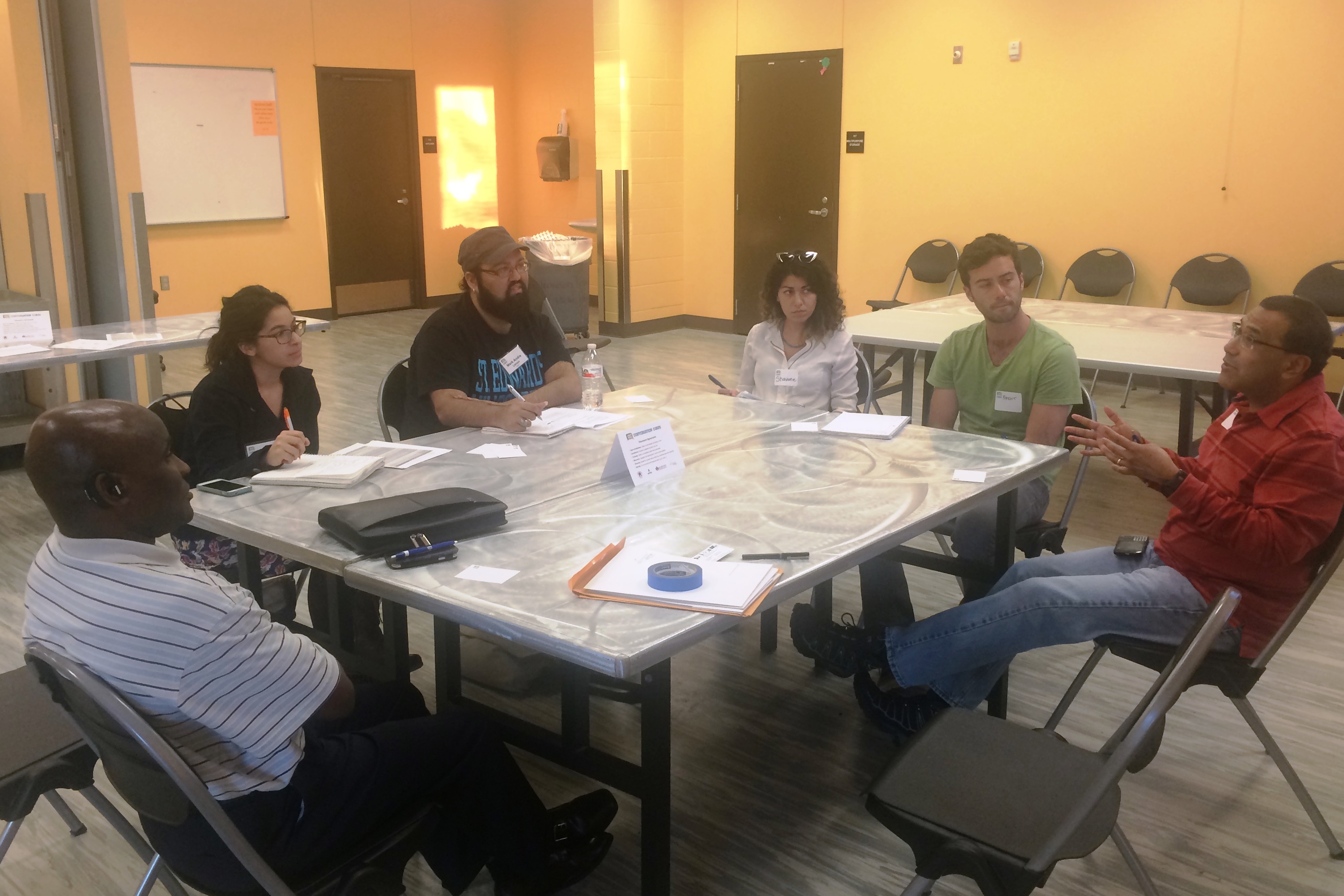United States
City of Austin, Capital Metro and Austin Independent School District
Since January, 2015
 11th.
11th.
Using an accessible model that brings conversations to comfortable and convenient settings, volunteers facilitate dialogue that enables participants to hear from others and learn from different perspectives.
There are three primary objectives of Conversation Corps: Give community members the skills needed to lead and participate in meaningful conversations; create opportunities for anyone and everyone to participate in dialogue about issues that impact them; and connect community dialogue with decision makers.
The first phase of Conversation Corps has successfully reached all 10 city council districts. We’ve heard from more than 700 voices from all over the city. Based on survey results from attendees, 44 perfect of respondents were male, 56 percent female. Participants have ranged in age from teenagers through senior citizens and come from incomes of less than $10,000 to more than $105,000. A little more than half of our respondents identified as White/Caucasian, 10 percent Hispanic/Latino, 10 percent Asian American, 6 percent African American and 10 percent other.
Austin’s population has doubled every 20 years for more than two centuries. Our city is such a desirable place to live for so many people that it is easy to miss the people who live in this thriving city and are barely surviving. It’s easy to miss them because if you’re doing well here you rarely cross paths with those who are not. Among all the lists that Austin is at the top of, “most socioeconomically segregated by geography” is one of them.
This dichotomy in the quality of life in Austin makes serving the entire population and making decisions that are in the best interest of everyone very difficult. Fortunately the past several years have seen a heightened commitment from Austin residents and decision makers to adapt to the growing needs of the region. In 2012 voters passed a measure to move from a council structure where all representatives were elected at large to a new structure in which the city is divided into 10 districts all of whom elect their own council member. When the new council was sworn in in January of 2015, every area of Austin had a voice representing them on the dais for the first time in Austin’s history.
The City quickly learned that populations that have never had their voices heard don’t start speaking up overnight. Having a representative on the council was a huge step in the right direction but along with it was a need to help people understand how to share their voice. The City’s Communications and Public Information Office felt an overwhelming responsibility to help the citizens of Austin play a role in making the new structure of city government successful. With these needs in mind, the concept of Conversation Corps was born.
As the weight of the need for more robust engagement laid heavily on the staff of the City’s Communications and Public Information Office, the team began exploring how to make it easier for anyone and everyone to share their voice. A vision was formed to offer more opportunities for people to participate in the decision making process outside of City Council meeting. The team envisioned an infrastructure to support engagement through small, intimate, non-intimidating environments, where people talked with each other through civil conversation instead of at one another from a podium.
This was a task that far exceeded the capacity of City staff, so the idea was created to train a large corps of volunteers who could go out and lead these conversations and then report back what they heard from people. In early 2013, the City approached other public agencies, gathered community members and began talking though how to bring this concept to life. It took a couple years to get the new initiative up and running, and in January of 2015, Conversation Corps publicly launched and trained its first 30 members of the Corps. Since then more than 100 volunteers have been through training.
With a solid foundation of volunteers, conversations began in May of 2015 and ran through July of 2016. The first phase of the pilot has successfully reached all 10 city council districts. We’ve heard from more than 700 voices from all over the city about 14 different topics. Conversations have taken place in coffee shops, libraries, recreation centers, houses of worship, neighborhood facilities and even on the train.

The second phase of the pilot began with a Day of Dialogue on Presidents’ Day 2017. After several months of strategic planning and assessing the success of the program thus far an updated model has been developed that will focus on training more volunteers and make hosting and attending conversations more flexible and convenient. We’ll be taking both training and dialogue opportunities into already existing groups and organizations. With more topics and more opportunities to participate, we look forward to an even greater impact.
As the program gains visibility, the hard to reach populations are becoming easier to reach. We’re confident that in the next phase of the program, as we take conversations into places where people already gather, we will truly move the needle on engaging with some of our most vulnerable community members - those that are significantly impacted by policy yet don’t have the capacity to be part of shaping that policy.
Reaching our entire population will require partnerships with the entities that everyday citizens encounter in their everyday lives, and building these relationships is a huge focus as we launch the new and improved model. One example is the partnership we’re building with Goodwill Industries of Central Texas to take conversations to their employees and clients. We’ll also be approaching other nonprofit organizations that serve our low-income areas of town in addition to employers large and small.
While the vision for Conversation Corps originally came out of the City’s Communications and Public Information Office, there have been many individuals at multiple agencies that have been absolutely crucial to the program’s creation and execution. The program manager, an employee of Leadership Austin - a local non-profit contracted by the City to administer the program – is responsible for day to do day management of the program including volunteer training and support. An operations team was formed early into the launch of the program, which is comprised of one “on the ground” representative from each organization. It is this operations team that make decisions about topics and the ongoing changes to the program. A steering committee has also been established to meet quarterly and make longer term strategic decisions about the program and the partnership.
In addition to the staff time that the agencies are willing to dedicate, the support from top leadership at each organization has been vital. The Mayor, the CEO of Capital Metro and the Superintendent at AISD all fully support this initiative. We also have an amazing group of incredibly committed volunteers who truly are the ones who bring the program to life.

City of Austin staff knew they were not the only professionals in the field of community engagement with limited resources and reached out to two other public agencies – Capital Metro, Austin’s regional public transportation provider; and the Austin Independent School District (AISD) – to engage them as co-creators of this initiative. The other agencies immediately jumped on board to collaborate, a partnership formed, and the concept of Conversation Corps began to evolve.
One major milestone was the commitment of Leadership Austin, a local non-profit, to join the effort. Leadership Austin was a natural fit because of their proven ability to train community members to engage in collaborative, inclusive, and sustainable leadership for our region. In addition, the partnering agencies of Conversation Corps sought the neutral and nonpartisan position that Leadership Austin holds in the community, the organization’s reputation of being well respected and trusted, and the “corps” of more than 2500 community-minded and engaged Leadership Austin alumni.
It is the collaboration of these four organizations that have brought Conversation Corps to where it is now. During the next phase of the initiative, a large focus will be placed on building more partnership within the community.
Themodel revolves around training volunteers who go out and facilitate dialogue in the community about important regional issues and then report back what they hear to the Conversation Corps partners – all of whom are public agencies. The conversation structure that train volunteers to use includes a final round in which themes are decided on by the group. We don’t look for consensus but simply agreement about the main themes that have surfaced during the hour-long conversation. Our volunteers then submit a report back to us with these themes. Our agencies compile themes from all of the conversations and develop reports and recommendations for the decision makers specific to each topic.
The type of feedback we receive from these conversations augments other input processes. Our methodology for this type of engagement captures the power of storytelling and personal experiences. As a result, Conversation Corps not only impacts policy, but also makes a positive lasting impact on everyone involved in the process. We’ve learned that our community can make decisions differently when we understand each other better. Conversation Corps brings the human touch back into what in many cases has become a mundane and impersonal experience.
The current (2017) budget for the program is $45,000. 95 percent of this funding is used to cover staff time to administer the program with the remaining funds used toward website hosting and basic materials.
Information about the program and how to participate is disseminated through all three public agencies as well as through Leadership Austin. Community members can sign up for a newsletter and will hear directly from Conversation Corps about ongoing opportunities as well as about how feedback is being used.
For each topic, background information is put together to help inform the dialogue. This is made public through our website. The feedback we receive is also published on the website and sent out through our newsletter and social media. For those who do not have readily available access to our website, they can call 3-1-1, Austin’s 24-hour Citywide Information Center, for all of the details.
As we build more partnerships with other community organizations and businesses, we will grow the ways in which information is shared and even more importantly who it is shared with.
A feedback loop is built into the program so that people who have participated in conversations can see how their input is being used. Once the feedback is compiled we publish it on our website so that everyone can see the themes from all of the conversations. We also keep our website updated with how the feedback is being used – who is using it, what decisions have been made and what decisions are still on the horizon. We ask all of our participants to give their contact information so that we can let them know that updates have been published. Our volunteers collect this contact information and submit it with their report.
This feedback loop enables all of our partnering agencies to say “we hear you even if we can’t address your concerns immediately.” It allows us to address misconceptions. It gives a glimpse into what we don’t know people don’t know. A common theme across almost every topic has been the desire for more information and education. People want more connection to the “how” and “why.” Many want solutions that already exist and it is a matter of connecting them with the resources they need.

Evaluation and monitoring
As the program grows, we measure all of the quantitative and qualitative data we can get our hands on to help drive strategy and decisions. We look to both the quality of the experience for everyone involved as well as the quantity and diversity of participants to measure our success.
We assess the quality of the experience on three levels - Are the supporting agencies satisfied? Are our volunteers feeling supported and successful? Is the experience meeting the expectations of the participants? This assessment is conducted through regular meetings with all of the partnering agencies, regular contact with and surveys from volunteers, and post-conversation surveys from participants.
The surveys also collect data that we need to measure the quantitative goals we must deliver to the leadership of our agencies.
Through Conversation Corps, community members who our agencies have never heard from are showing up and getting involved. More voices are being heard and included in policy decisions. As we persistently work toward growing the number of people who participate in Conversation Corps, which will allow the input to have even more influence on policy decisions, we fervidly celebrate the unquantifiable impact we see in the community. People are learning to talk to each other differently. They are listening to one another and walking away from conversations saying “I hadn’t thought about it that way before.” We continue to work toward making sure participants are truly heard by our agencies and at the same time ensuring that they are being heard by one another. We know that if we can change the way our community understands issues from multiple perspectives, it will change the way we’re able to serve everyone’s needs. Community members can have their needs heard and be the voice for other people at the same time. This achievement has a ripple effect throughout our community. In a country that is incredibly divided, we need the compassion and understanding that accompanies civil discourse now more than ever.

Interesting initiative to increase dialogue and deliberation in Austin, Texas. The goal of the Conversation Corps is to include a diverse set of population for discussion meetings, to mitigate segregation and "bubbles" among the city residents. The model looks promising.